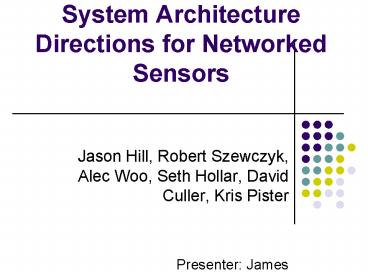System Architecture Directions for Networked Sensors - PowerPoint PPT Presentation
1 / 18
Title:
System Architecture Directions for Networked Sensors
Description:
... Sensors. Jason Hill, Robert Szewczyk, Alec Woo, Seth Hollar, David Culler, Kris Pister ... How to combine sensing, communication and computation into a ... – PowerPoint PPT presentation
Number of Views:163
Avg rating:3.0/5.0
Title: System Architecture Directions for Networked Sensors
1
System Architecture Directions for Networked
Sensors
- Jason Hill, Robert Szewczyk, Alec Woo, Seth
Hollar, David Culler, Kris Pister - Presenter James
2
Computing in millimeters
- Advances in low power wireless communication
technology and micro-electromechanical sensors
(MEMS) make this possible - How to combine sensing, communication and
computation into a complete architecture - What are the requirements of the software?
3
Organization
- Hardware of today
- Software Requirements
- TinyOS system architecture
- System evaluation
4
Todays Hardware
- Assembled from off-the-shelf components
- 4Mhz, 8bit MCU (ATMEL)
- 512 bytes RAM, 8K ROM
- 916.5Mhz Radio (RF Monolithics)
- 10-100 ft. range
- Temperature Sensor Light Sensor
- LED outputs
- Serial Port
1.5 x 1.5
5
Todays Hardware (cont.)
- Bit by bit interaction with Radio
- No buffering
- missed deadline ? lost data
- No dedicated I/O controllers
6
Key Software Requirements
- Capable of fine grained concurrency
- Small physical size
- Efficient Resource Utilization
- Highly Modular
7
Real time operating systems
- VxWorks in hundreads of kilobytes
- QNX context switch 2400 cycles on x86
- Creem no preemption
8
TinyOS system architecture
9
TinyOS component model
- Component has
- Frame (storage)
- Tasks (computation)
- Command and Event Interface
- Constrained Storage Model allows compile time
memory allocation - Provides efficient modularity
- Explicit Interfaces help with robustness
Messaging Component
Internal State
Internal Tasks
Commands
Events
10
TinyOS Component
- //AM.comp//
- TOS_MODULE AM
- ACCEPTS
- char AM_SEND_MSG(char addr, char type,
char data) - void AM_POWER(char mode)
- char AM_INIT()
- SIGNALS
- char AM_MSG_REC(char type, char
data) - char AM_MSG_SEND_DONE(char success)
- HANDLES
- char AM_TX_PACKET_DONE(char success)
- char AM_RX_PACKET_DONE(char packet)
- USES
- char AM_SUB_TX_PACKET(char data)
- void AM_SUB_POWER(char mode)
- char AM_SUB_INIT()
AM_SEND_MSG
AM_INIT
AM_POWER
AM_MSG_SEND_DONE
AM_MSG_REC
Messaging Component
Internal State
Internal Tasks
AM_SUB_POWER
AM_TX_PACKET_DONE
AM_SUB_TX_PACKET
AM_RX_PACKET_DONE
AM_SUB_INIT
Commands
Events
11
State Machine Model
- System composed of state machines
- Command and event handlers transition a module
from one state to another - Quick, low overhead, non-blocking state
transitions - Many independent modules are allowed to
efficiently share a single execution context
12
A Complete Application
sensing application
application
Routing Layer
routing
Messaging Layer
messaging
Radio Packet
packet
Radio byte
Temp
byte
photo
SW
HW
RFM
i2c
ADC
bit
clocks
13
Analysis
- Lets take apart Space, Power and Time
14
Space Breakdown
Code size for ad hoc networking application
Scheduler 144 Bytes code Totals 3430 Bytes
code 226 Bytes data
15
Energy
- It turns out energy is your most valuable
resource - Traditional notions of resources memory, CPU,
I/O become expenses, not resources - All components must support low power modes
16
Power Breakdown
Energizer CR2450 575 mAh
- What does this mean?
- Lithium Battery runs for 28 hours at peak load
and years at minimum load! - All its energy can only support 144KB data
17
Time Breakdown
- 50 cycle thread overhead (6 byte copies)
- 10 cycle event overhead (1.25 byte copes)
18
An Example Timing Diagram
- Message Send Transition
19
Conclusions
- TinyOS is a highly modular software environment
tailored to the requirements of Network Sensors,
increasing efficiency, modularity and concurrency
20
Discussions
- Transmitting encoding
- Zeros and Ones
- Acks and retransmissions
- Data compression, aggregation, etc.
- Single MCU vs. multiple MCUs
- Concurrency-intensive operation?
- Power allocation
- Other ways of power conservation
- Duty cycle
- Lower accuracy































